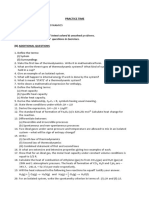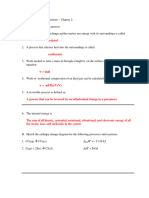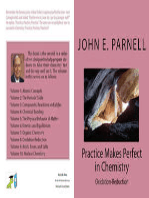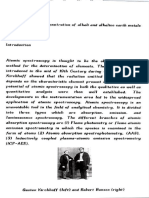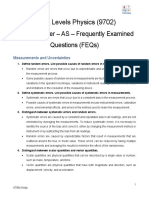2011 Final Answer
Uploaded by
xuan10022011 Final Answer
Uploaded by
xuan10021
Chemistry I -- Final Exam
2012/1/13
Periodic Table of Elements
Constants
R = 8.314 J / mol K 1 atm = 760 Torr = 1.01x10
5
Pa
= 0.0821 L atm / K mol c = 2.9910
8
m/s
= 8.314 L kPa / K mol h = 6.6310
-34
Js
Mass of e , m
e
= 9.10939 10
-31
kg k = 1.3810
-23
J/K
2
1. (10%) If 2.00 mol of an idea gas at 300K and 3.00 atm expands from 6.00 L to
18.00 L and has a final pressure of 1.00 atm, isothermally and reversibly, calculate
the w, q and U?
2. Benzoic acid has a known internal energy of combustion (-3251 kJ/mol). When a
bomb calorimeter was calibrated by burning 0.825 g of benzoic acid (C
6
H
5
COOH)
in oxygen, the temperature rose 1.94 C. A 0.727 g sample of the sugar D-ribose
(C
5
H
10
O
5
) was then burned in excess oxygen in the same calorimeter, forming
gaseous CO
2
and liquid H
2
O. The temperature of the calorimeter rose from
21.81C to 22.72C.
(a) (5%) Write a balanced equation for the combustion.
(b) (5%) Calculate heat capacity of bomb calorimeter.
(c) (5%) Calculate the internal energy change, U, for the combustion of 1.00 mol
ribose molecules.
3. (5%) The standard molar heat of combustion of the isomers m-xylene and p-xylene
are -4553.9 kJ/mol and -4556.8 kJ/mol, respectively. Use the data, together with
Hesss Law, to calculate the value of H
r
for the isomerization reaction
m-xylene p-xylene.
4. (10%) An idea gas mixture consists of N and N
2
. At room temperature, only
translational and rotational motion contribute to heat capacity of the mixture, C
v
, is
found to be 9R (translation) and 4R (rotational), respectively. Find the mole
fraction of N
2
.
5. (10%) Given the following standard reaction enthalpies:
O
2
(g) 2O(g) H = +498.4 kJmol
1
NO(g) + O
3
(g) NO
2
(g) + O
2
(g) H = 200.0 kJmol
1
And the standard enthalpy of formation of ozone, +142.7 kJmol
1
, calculate the
standard reaction enthalpy for the reaction
NO(g) + O(g) NO
2
(g)
6. (8%) (a) Define statistical entropy and explain it; (b) Which would you expect to
have a higher molar entropy at 0 K, single crystals of BF
3
or of COF
2
? Why?
3
7. (8%) List the following substances in order of increasing molar entropy at 298 K:
H
2
O(l), H
2
O(g); H
2
O(s), C(s, diamond). Explain your reasoning.
8. (8%) Show that if two metal blocks with different temperatures, T
1
, T
2
and T
1
< T
2
,
are placed in contact, then the direction of spontaneous change is toward the
equalization of temperatures. Assume that the temperatures of the blocks remain
constant individually.
9. (10%) (a) Verify the Clausius inequality, S
. (b) Use the change in free
energy to explain how an endothermic reaction can be spontaneous.
10. (6%) Calculate the standard Gibbs free energy of formation of HI(g) at 25C.
Given: AH
f
(HI, g) = 26.48 kJ mol
-1
; S
m
(in J K
-1
mol
-1
): H
2
(g) = 130.7, I
2
(s) =
116.1, HI(g)= 206.6.
11. (10%) Show that the change in Gibbs free energy for a process is equal to the
maximum nonexpansion work that the system can do at constant temperature and
pressure, i.e. dG = d
,
or G =
,
.
4
Answers:
1. isothermally T=0
U = C
v
T = C
v
0 = 0. (2%)
w = nRTln(v
f
/v
i
) = -28.314300ln(18/6) = 5480J = 5.48 kJ. (4%)
q =U-w = +5.48 kJ. (4%)
.
2. (a) (5%)
(b) benzoic acid ,
Heat released on combustion of 0.825g:
heat capacity of bomb calorimeter, C =
=
21.96
1.94
= 11.32
1
(5%)
(c) D-ribose, , molecular mass = 150.13 g mol
1
Bomb calorimeter is a fixed volume. AU = q + w = q
Heat released by reaction, q
(released)
= heat gained by calorimeter, q
(gained)
On combustion of 0.727g (or ) of D-ribose
Per mole of D-ribose,
(5%)
(l) 2 2(g) 2 5 10 5
O 5H 5CO 5O O H C + +
C
6
H
5
COOH
1
mol . g 12 . 122
0.825g
122.12 g. mol
1
= 6.755 10
3
mol
kJ 96 . 21
) mol . kJ 3251 )( mol 10 755 . 6 (
1 3
=
=
q
5 10 5
O H C
0.727 g
150.13 g. mol
1
= 4.842 10
3
mol
0 (gained) (released) = + q q
kJ 30 . 10
) C 81 . 21 C 72 . 22 )( C . kJ 32 . 11 (
1
) gained ( ) released (
=
=
A =
=
T C
q q
mol 10 842 . 4
3
kJ 30 . 10 ) released ( = = A q U
mol 10 842 . 4
kJ 30 . 10
3
= AU
= 2127.5 kJ. mol
1
5
3. m-xylene combustion products H
r
= -4553.9 kJ
+ combustion products p-xylene H
r
= +4556.8 kJ
=> m-xylene p-xylene H
r
= + 2.9 kJ
4. N is atom, C
v
= 3/2 R. (2%)
N
2
is diatomic molecule, C
v
= 5/2 R. (2%)
Assume x moles of N, y moles of N
2
Translational: 3/2 R (x+y) = 9R (2%)
Rotational: yR = 4R (2%)
y = 4, and x = 2
mole fraction of N = 1/3, mole fraction of N
2
= 2/3 (2%)
5. NO(g) + O
3
(g) NO
2
(g) + O
2
(g) H = 200.0 kJmol
1
(2%)
3/2 O
2
(g) O
3
(g) H = +142.7 kJmol
1
(2%)
O(g) O2
(g) H = - 249.2 kJmol
1
(2%)
NO(g) + O(g) NO
2
(g) H = -306.5 kJmol
1
(4%)
6. (a) S = k lnW, (2%)
k: Boltzmann constant (1%)
W 3 (2%)
W
W: the number of ways that the atoms or molecules in the sample can be
arranged and yet still give rise to the same total energy
W: the number of different microstates that correspond to the same energy
(b) COF
2
. (2%)
(2%)
COF
2
and BF
3
are both trigonal planar molecules, but it would be possible for
the molecule to be disordered with the fluorine and oxygen atoms occupying
the same locations. Because all the groups attached to boron are identical, such
disorder is not possible.
6
W(COF
2
)=3 and W(BF
3
)=1,
W(COF
2
) > W(BF
3
) COF
2
has a higher molar entropy.
7. C(s, diamond) < H
2
O(s) < H
2
O(l) < H
2
O(g) (4%)
It is easy to order
2
H O in its various phases because entropy will increase when
going from a solid to a liquid to a gas. (
H
2
O(s) < H
2
O(l) < H
2
O(g)) (2%)
(2%)
The main question concerns where to place C(s, diamond) in this order, and
that will essentially become a question of whether C(s, diamond) should have
more or less entropy than
2
H O(s) , because we would automatically expect
C(s, diamond) to have less entropy than any liquid. Because water is a
molecular substance held together in the solid phase by weak hydrogen bonds,
and in C(s, diamond) the carbon is more rigidly held in place and will have less
entropy.
DiamondCHO
W(H
2
O, solid) > W(C, diamond)
8.
Assume the transfer of energy as heat is reversible. The change in entropy for each
block (block 1 and block 2) are:
1 2
1 2
1 2
and
q q
S S
T T
A = A = (2%)
Energy is transferred, then the change in entropy for the system is:
2
2
1
1
2 1
T
q
T
q
S S S + = A + A = A (2%)
Only when energy is transferred from hot to cold block,
7
q
1
> 0, q
2
< 0 and q
1
= -q
2
, (2%)
AS = q
1
/T
1
q
1
/T
2
> 0, (2%)
the process is spontaneous.
Assume the transfer of energy as heat is reversible and the heat is assigned as q,
where q>0. If the energy is transferred from hot (T
2
) to cold block (T
1
), the
change in entropy for each block (block 1 and block 2) are:
1
=
(4%)
Then, the change in entropy for the total system is:
|
|
.
|
\
|
= +
+
= A + A = A
2 1
1 2
2 1
2 1
-
S S S
T T
T T
q
T
q
T
q
(2%)
T
2
> T
1
and q>0
|
|
.
|
\
|
= A
2 1
1 2
S
T T
T T
q > 0, (2%)
The process for the energy transferred from hot (T
2
) to cold block (T
1
) is
spontaneous.
9. (a) (5%) Clausius inequality AS > q/T. For reversible processes, AS = q/T. For
irreversible processes, q
rev
> q
irrev
. AS = q
rev
/T > q
irrev
/T.
(b) (5%) If
r
AG < 0, (
r
AG is negative); the process is spontaneous.
A = A A
r r r
G H T S If a reaction is endothermic
r
AH is positive, then the
reaction will be spontaneous only if A
r
T S is larger than
r
AH . So, effectively, a
reaction that is endothermic can be spontaneous only if the entropy change in the
system outweighs the enthalpy changes effect on the entropy of the surroundings.
10. H
2
(g) + I
2
(s) HI(g)
AH = 1 mol AH
f
(HI, g) = 1 mol (+26.48) kJ mol
-1
; = +26.48 kJ (2%)
AS = S
m
(HI, g) {0.5 S
m
(H
2
, g) +0.5 S
m
(I
2
, s)}
8
= 1 mol 206.6 J K
-1
mol
-1
{ 0.5 mol 130.7 + 0.5 mol 116.1} J K
-1
mol
-1
= +83.2 J K
-1
. (2%)
AG = AH -TAS = 26.48+298*83.2/1000 = +51.27 kJ (2%)
11.
w
rev,e
w
rev,non
(nonnon-expansion work)
d
therefore do, can system at the on work th nonexpansi maximun the is Because
(1%)
into and Insert
(1%)
(1%)
(1%)
process reverdible a For
(1%)
(2%) pressure and emperature constant t at
(1%) pressure constant at
(1%) emperature constant t at
e
e
e
e expansion
rev,e
rev
rev
rev
rev rev rev
rev
dw
dw dG
TdS PdV dw PdV TdS dG
dG dw dq
dw PdV dw
dw dw dw dw
TdS dq dq
TdS PdV dw dq dG
TdS PdV dU dG
PdV dU dH
TdS dH dG
=
+ + =
+ =
+ = =
= =
+ + =
+ =
+ =
=
dG = dw
e, max
at constant T and P (1%)
You might also like
- Brown - Introduction To Thermal Analysis. Techniques and Applications PDF100% (1)Brown - Introduction To Thermal Analysis. Techniques and Applications PDF267 pages
- (@bohring - Bot) SHEET-3-SECOND LAW, GIBB'S FREE ENERGYNo ratings yet(@bohring - Bot) SHEET-3-SECOND LAW, GIBB'S FREE ENERGY4 pages
- Write Answers To All NCERT Intext Solved & Unsolved Problems. 2. Write Answers To All NCERT Questions in ExercisesNo ratings yetWrite Answers To All NCERT Intext Solved & Unsolved Problems. 2. Write Answers To All NCERT Questions in Exercises3 pages
- Thermodynamics JEE-Main. Test - 1 RPS QuestionsNo ratings yetThermodynamics JEE-Main. Test - 1 RPS Questions4 pages
- Chemistry 1 Thermodynamics Final and SolutionsNo ratings yetChemistry 1 Thermodynamics Final and Solutions11 pages
- Unit 5 Thermodynamics - Subjective AssignmentNo ratings yetUnit 5 Thermodynamics - Subjective Assignment2 pages
- Thermodynamics: I Puc - Chemistry Chapter - 06100% (1)Thermodynamics: I Puc - Chemistry Chapter - 0611 pages
- 1 - 1 - 1 - 1 F I Cal - 1 - 1 - 1 Cal Cal - 1 - 1 - 1 - 1 - 1No ratings yet1 - 1 - 1 - 1 F I Cal - 1 - 1 - 1 Cal Cal - 1 - 1 - 1 - 1 - 13 pages
- Thermodynamics Nd Thermochemistry Worksheetsandy-1-18_compressedNo ratings yetThermodynamics Nd Thermochemistry Worksheetsandy-1-18_compressed18 pages
- Class-XI Chemistry Thermodynamics Worksheet DocumentNo ratings yetClass-XI Chemistry Thermodynamics Worksheet Document2 pages
- Thermodynamics _ Practice Sheet __ Uday TitansNo ratings yetThermodynamics _ Practice Sheet __ Uday Titans5 pages
- THERMO CHEMISTRY & THERMO DYNAMIC TEST 50 qUESNo ratings yetTHERMO CHEMISTRY & THERMO DYNAMIC TEST 50 qUES7 pages
- Thermodynamics 04 - Class Notes - (Varun Advanced 2023)No ratings yetThermodynamics 04 - Class Notes - (Varun Advanced 2023)41 pages
- JEE Main Chemical Thermodynamics Important Questions - Free PDF DownloadNo ratings yetJEE Main Chemical Thermodynamics Important Questions - Free PDF Download16 pages
- Gen Chem II Exam I Practice Problems Sp07No ratings yetGen Chem II Exam I Practice Problems Sp076 pages
- Thermochemistry Review - Answers: CH OH (L) + / O (G) Î Co (G) + 2 H O (L) H - 727 KJNo ratings yetThermochemistry Review - Answers: CH OH (L) + / O (G) Î Co (G) + 2 H O (L) H - 727 KJ12 pages
- Practice Makes Perfect in Chemistry: Oxidation-Reduction with AnswersFrom EverandPractice Makes Perfect in Chemistry: Oxidation-Reduction with AnswersNo ratings yet
- Newton's Laws of Motion - Wikipedia, The Free EncyclopediaNo ratings yetNewton's Laws of Motion - Wikipedia, The Free Encyclopedia13 pages
- Class 12 Physics Notes Chapter 3&4 Studyguide360No ratings yetClass 12 Physics Notes Chapter 3&4 Studyguide36046 pages
- 9702 Grade Booster-AS-Frequently Examined Questions FEQsNo ratings yet9702 Grade Booster-AS-Frequently Examined Questions FEQs20 pages
- Chapter 1-Electronic Structure of Atoms (2015)No ratings yetChapter 1-Electronic Structure of Atoms (2015)30 pages
- Experiment - 7: Aim: Sizing of Pressure VesselNo ratings yetExperiment - 7: Aim: Sizing of Pressure Vessel5 pages
- (Ii) Eequatorial : (Ii) E¡xial and For Short Dipole, E¡xial and For Short Dipole EequatorialNo ratings yet(Ii) Eequatorial : (Ii) E¡xial and For Short Dipole, E¡xial and For Short Dipole Eequatorial4 pages
- Quadcopter Simulation: Jose Carlos LopezNo ratings yetQuadcopter Simulation: Jose Carlos Lopez4 pages
- Chapter 3 Centrifugal Compressors and Fans (Modified)No ratings yetChapter 3 Centrifugal Compressors and Fans (Modified)44 pages
- Brown - Introduction To Thermal Analysis. Techniques and Applications PDFBrown - Introduction To Thermal Analysis. Techniques and Applications PDF
- (@bohring - Bot) SHEET-3-SECOND LAW, GIBB'S FREE ENERGY(@bohring - Bot) SHEET-3-SECOND LAW, GIBB'S FREE ENERGY
- Write Answers To All NCERT Intext Solved & Unsolved Problems. 2. Write Answers To All NCERT Questions in ExercisesWrite Answers To All NCERT Intext Solved & Unsolved Problems. 2. Write Answers To All NCERT Questions in Exercises
- 1 - 1 - 1 - 1 F I Cal - 1 - 1 - 1 Cal Cal - 1 - 1 - 1 - 1 - 11 - 1 - 1 - 1 F I Cal - 1 - 1 - 1 Cal Cal - 1 - 1 - 1 - 1 - 1
- Thermodynamics Nd Thermochemistry Worksheetsandy-1-18_compressedThermodynamics Nd Thermochemistry Worksheetsandy-1-18_compressed
- Class-XI Chemistry Thermodynamics Worksheet DocumentClass-XI Chemistry Thermodynamics Worksheet Document
- Thermodynamics 04 - Class Notes - (Varun Advanced 2023)Thermodynamics 04 - Class Notes - (Varun Advanced 2023)
- JEE Main Chemical Thermodynamics Important Questions - Free PDF DownloadJEE Main Chemical Thermodynamics Important Questions - Free PDF Download
- Thermochemistry Review - Answers: CH OH (L) + / O (G) Î Co (G) + 2 H O (L) H - 727 KJThermochemistry Review - Answers: CH OH (L) + / O (G) Î Co (G) + 2 H O (L) H - 727 KJ
- Practice Makes Perfect in Chemistry: Oxidation-ReductionFrom EverandPractice Makes Perfect in Chemistry: Oxidation-Reduction
- Heat: The Nature of Temperature and Most Other PhysicsFrom EverandHeat: The Nature of Temperature and Most Other Physics
- Practice Makes Perfect in Chemistry: Oxidation-Reduction with AnswersFrom EverandPractice Makes Perfect in Chemistry: Oxidation-Reduction with Answers
- Newton's Laws of Motion - Wikipedia, The Free EncyclopediaNewton's Laws of Motion - Wikipedia, The Free Encyclopedia
- 9702 Grade Booster-AS-Frequently Examined Questions FEQs9702 Grade Booster-AS-Frequently Examined Questions FEQs
- (Ii) Eequatorial : (Ii) E¡xial and For Short Dipole, E¡xial and For Short Dipole Eequatorial(Ii) Eequatorial : (Ii) E¡xial and For Short Dipole, E¡xial and For Short Dipole Eequatorial
- Chapter 3 Centrifugal Compressors and Fans (Modified)Chapter 3 Centrifugal Compressors and Fans (Modified)




